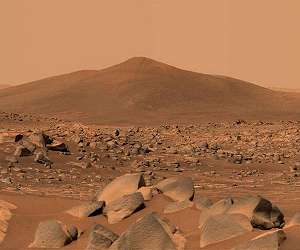Perseverance capped its first year on Mars by speeding back around Seitah toward what is expected to be the final sampling location in its crater floor campaign. The drive on Mars was split across three different sols executing instructions planned in a single day on Earth, making this Perseverance’s first multiple-sol drive.
Why are we excited about the multiple-sol drive? It creates an opportunity to drive a great distance in a longer plan, typically during holidays or weekends when new planning doesn’t occur on Earth.
Recently in the sol 350-352 plan we commanded a three-sol drive that resulted in the longest-single-sol total distance recorded by any Mars rover (319.79m) on sol 351, and the longest distance of any Mars rover in a single plan without ground intervention (509.75m). Two reasons that made the multiple-sol drive more challenging than driving the same distance in three single-sol plans are uncertainty and complexity.
Autonav is very good at detecting the geometric obstacles it encounters near the rover (like large rocks and high slopes) and avoids these. There are certain non-geometric hazards, like sand that it is does not detect on its own and rover planners mark these areas using “keep-out-zone” locations in the rover’s world map, which serves as it’s map of Mars.
As the rover drives it accumulates some uncertainty, or error, in its knowledge of where it is on Mars. Even though its Visual Odometry (VO) capability is able to measure and compensate for slip, making this relatively small, the uncertainty accumulates over large distances.
The rover knows that as it’s driving its knowledge of where the keep-out-zones are is getting less certain. Perseverance models that knowledge as an accumulating “uncertainty distance” and will enlarge keep-out zones by that amount.
A viable corridor with one or more edges along a keep-out-zone can therefore potentially shrink by tens of meters making it challenging for Autonav to find a path through terrain in the far distance.
We reset the position uncertainty to zero every time we uplink a new set of drive instructions because we also localize the rover precisely on Mars. This makes corridors within a single-sol distance easier for Autonav to navigate and we used this in the sol 353 drive as we drove up North.
Planning a three-sol drive is also more complex because we must create and evalute three times as many drive path segments and associated terrain evaluations. At planning time we cannot know exactly where the previous autonomous drive will end up on Mars, and this needs to be factored into each sol’s drive plan. Longer command creation and review times are also compressed into a single planning day.
We have arried at Ch’al for our final crater floor sampling and are looking forward to many more multiple-sol drives on our journey to the Jezero delta!
Related Links
Perseverance Mars 2020
Mars News and Information at MarsDaily.com
Lunar Dreams and more
|
We need your help. The SpaceDaily news network continues to grow but revenues have never been harder to maintain. With the rise of Ad Blockers, and Facebook – our traditional revenue sources via quality network advertising continues to decline. And unlike so many other news sites, we don’t have a paywall – with those annoying usernames and passwords. Our news coverage takes time and effort to publish 365 days a year. If you find our news sites informative and useful then please consider becoming a regular supporter or for now make a one off contribution. |
||
|
SpaceDaily Contributor $5 Billed Once credit card or paypal |
SpaceDaily Monthly Supporter $5 Billed Monthly paypal only |
|

![]()
Ch’al-Type Rocks at Santa Cruz
Pasadena CA (JPL) Feb 25, 2022
NASA’s Perseverance Mars rover snapped this view of a hill in Mars’ Jezero Crater called “Santa Cruz” on April 29, 2021, the 68th Martian day, or sol, of the mission. About 20 inches (50 centimeters) across on average, the boulders in the foreground are among the type of rocks the rover team has named “Ch’al” (the Navajo term for “frog” and pronounced “chesh”). Perseverance will return to the area in the next week or so.
Composed of multiple images, this enhanced-color mosaic was created using the … read more